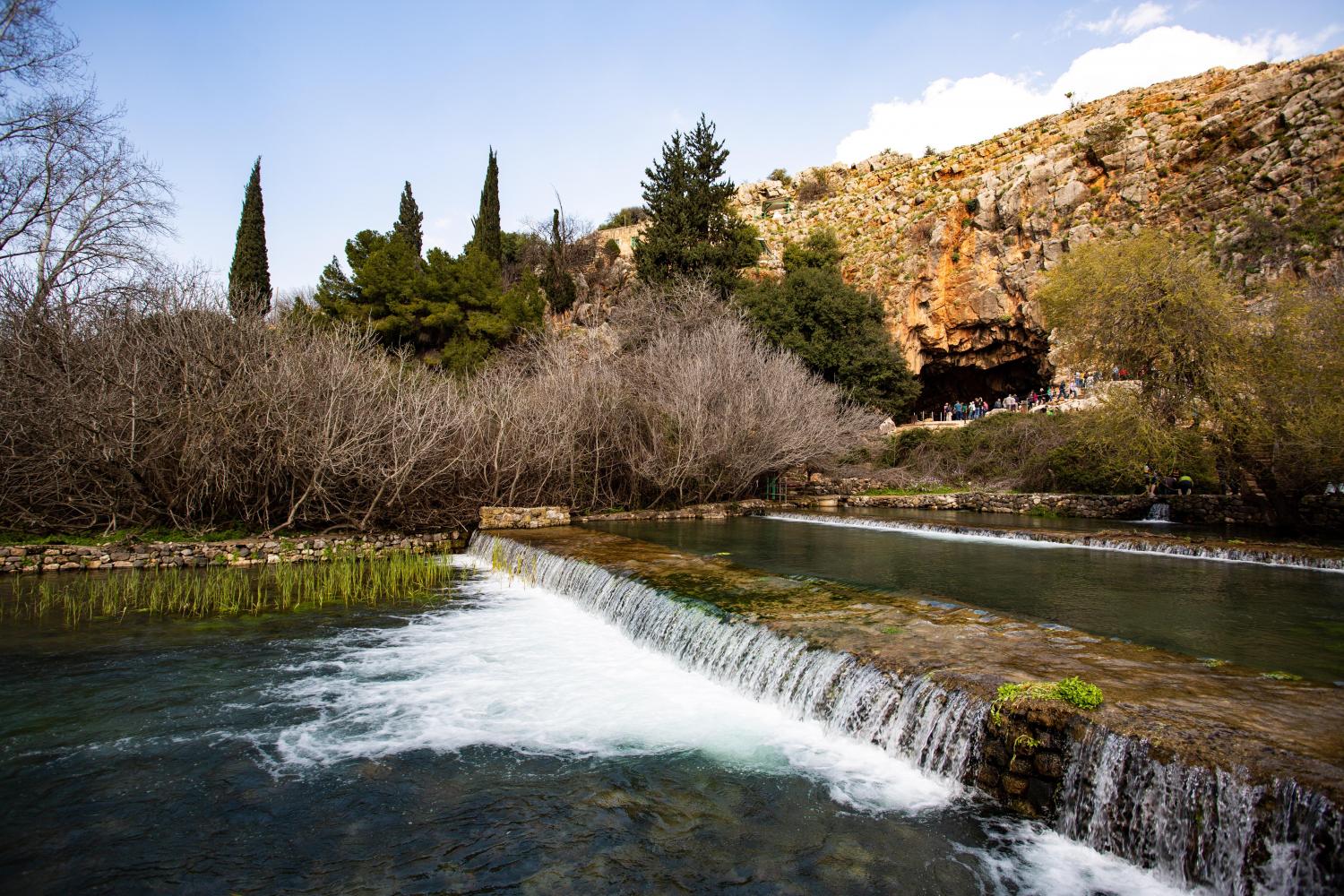Digging Deeper: Cæsarea Philippi
Author: Mr. Kenneth Frank | Faculty in Theology, Living Education
Estimated reading time: 8 min.
Did you know that one of the greatest confessions of faith in Christ was made by an apostle while traveling with Jesus to a northerly Gentile area near Caesarea Philippi?
After traveling with his disciples for some time, Jesus decided to ask them who they thought He was. This was also the occasion when Jesus assigned the future leadership of the church, after He ascended to Heaven, to the apostle Peter. Historically, Caesarea Philippi had been a center of pagan worship. This Digging Deeper researches the verbal exchange between Jesus and His disciples to better understand why Jesus chose this distant geographical location to discuss His identity and prepare them for His coming death and ascension to heaven.
Our focus passage is: “When Jesus came into the coasts [region] of Caesarea Philippi, he asked his disciples, saying, Whom do men say that I the Son of man am? And they said, Some say that thou art John the Baptist: some, Elias; and others, Jeremias, or one of the prophets. He saith unto them, But whom say ye that I am? And Simon Peter answered and said, Thou art the Christ, the Son of the living God. And Jesus answered and said unto him, Blessed art thou, Simon Barjona: for flesh and blood hath not revealed it unto thee, but my Father which is in heaven” (Matthew 16:13-17 KJV throughout). Peter’s confession of faith revealed the kind of disciple he was deep inside even though he failed to understand Christ at times (Matthew 16:23).
Jesus journeys North
This episode was during Jesus’ withdrawals from Jewish territories because of opposition He was facing, as explained by Ellicott’s Commentary for English Readers: “The order of the journeyings of our Lord and His disciples would seem to have been as follows:—From the coasts of Tyre and Sidon they came, passing through Sidon, to the eastern shore of the Sea of Galilee (Mark 7:31); thence by ship to Magdala and Dalmanutha, on the western shore (Matthew 15:39; Mark 8:10); thence, again crossing the lake (Mark 8:13), to the eastern Bethsaida (Mark 8:22); thence to Cæsarea Philippi. There is in all these movements an obvious withdrawal from the populous cities which had been the scene of His earlier labours, and which had practically rejected Him and cast in their lot with His enemies” (e-Sword 13.0.0).
Matthew reports that Jesus came to the coasts (region) of Caesarea Philippi (Matthew 16:13). Mark clarifies further that Jesus came to the towns of Caesarea Philippi (Mark 8:27), not the city itself. This was the extreme northeast corner of Galilee near the source of the Jordan River and was located at the base of the southwest slope of Mt. Hermon. It was also near the former border of the tribe of Naphtali and was the most northerly area of Palestine that Jesus visited. This trip was shortly before His transfiguration, as described in Matthew 17. Fausset’s Bible Dictionary notes: “The transfiguration probably took place on mount Hermon which rears its majestic head 7,000 feet above Caesarea Philippi” (e-Sword 13.0.0).
The ESV Study Bible provides essential background material for this city: “Caesarea Philippi, some 25 miles (40 km) north of the Sea of Galilee, had been a center of the worship of (1) Baal, then of (2) the Greek god Pan, and then of (3) Caesar. At this time it was an important Greco-Roman city, with a primarily pagan Syrian and Greek population. In fact, its name had recently been changed from Paneas to Caesarea Philippi by Philip the Tetrarch (one of Herod the Great’s sons), in honor of himself and Augustus Caesar. Excavations at the site have revealed coins minted to depict the temple built to honor Augustus Caesar, and a pagan cave dedicated to Pan, with shrines and cult niches that are still visible today” (Tecarta Bible App). Pan was the Greek god of the forest, shepherds, nature, and fertility. He was depicted as half man and half goat. During a summer archaeological dig in Jerusalem in 1971, over 70 of us Ambassador College students saw these cult niches during a day trip to this area.
The Son of Man
In Matthew 16:13, Jesus asked His followers what was being said about Him by the common people, not the Pharisees, Sadducees, and teachers of the Law. Then He pointedly asked His disciples what they thought of Him, as explained by the New King James Study Bible: “In the face of the surrounding idols, Christ led His disciples into a proclamation of His deity by first soliciting from them what other people said. In the end, however, what mattered was the apostles’ own beliefs concerning Jesus” (Tecarta Bible App). Peter, the spokesman for these disciples, proclaimed Jesus as the Christ, the Son of the living God, thereby acknowledging Jesus’ divinity.
Notice that Jesus referred to Himself as “the Son of man.” Joseph Sutcliffe’s Commentary on the Old and New Testaments explains: “It is very remarkable, that when our Saviour was about to disclose his Godhead, he calls himself the Son of man, which marks his humanity, that he was the son of Adam, or rather, the second Adam, the promised Seed. The same name was given Ezekiel, when favoured with high revelations, but in a different sense to this title of Christ: for in Christ it signifies the sovereign Judge of heaven and earth, the Father having given him authority to execute judgment, because he is by preëminence the Son of man. John 5:27” (e-Sword 13.0.0).
Bob Utley’s You Can Understand the Bible expands this further: “This phrase was used several times in the OT. It implies humanity (Psalm 8:4; Ezekiel 2:1) and deity (Daniel 7:13). The phrase was not used by the rabbis of Jesus’ day; therefore, it had no nationalistic or militaristic implications. This was Jesus’ self-chosen designation because it combined the twin aspects of His person, fully God and fully man (cf. Philippians 2:6-8; 1 John 4:1-3). See note at Matthew 8:20” (e-Sword 13.0.0).
The object lesson of “the rock”
It was after Peter’s confession of faith that Jesus gave him the keys of the kingdom of heaven, authorizing Peter as the human leader of the new church in Jesus’ absence (Matthew 16:18-19). Jesus declared He would build His church upon “this rock” – referring to Himself. It was not a coincidence that Jesus chose this location to announce it, as explained by the New King James Study Bible: “The site for pagan worship centered on a massive stone facade, which Jesus referred to in His play on words concerning ‘rock’ in v. 18” (Tecarta Bible App). The surrounding rock made an impressive object lesson for these disciples.
This story appears in the three Synoptic Gospels: Matthew 16:13-20; Mark 8:27-30; Luke 9:18-21. In all three, Jesus concluded the conversation by commanding the disciples to tell no man that He was Jesus the Christ. Scholars refer to this as “the Messianic Secret.” At that time, many Jews expected a conquering champion Messiah who would rid the Holy Land of the despised Romans and restore the glory days of David and Solomon. Jesus had not come at that time to conquer the world. Rather, He came to die as the sacrifice for human sin. He foretold His death and resurrection soon after this discussion about His identity (Matthew 16:21-23).
Why did Jesus choose this spot to reveal His identity and prepare them for the establishment of His church? The Holman KJV Study Bible replies: “That Jesus’ identity as the Messiah was announced here demonstrates that Jesus is superior to Caesar and to all idols and mythical gods” (Tecarta Bible App). At that time, Caesar was declared by many as the divine son of God who brought peace (Pax Romana) to the Roman world. By contrast, Jesus called for their full allegiance to Him as Savior and King of the world.
Jesus knew His time with them was limited and that He needed to prepare His disciples to carry on preaching the gospel in His absence, as explained by the Preacher’s Complete Homiletical Commentary, edited by Joseph S. Exell: “This conversation at Cæsarea Philippi is universally regarded as marking a new era in the life of Christ. His rejection by ‘His own’ [the Jews] is now complete.… With the very small band He has gathered around Him He withdraws to the neighbourhood of the Gentile town of Cæsarea Philippi; not for seclusion only, but, as the event shows, to found an Ecclesia—His church (Gibson)” (e-Sword 13.0.0). That church continues to proclaim His royal gospel to the world even today.

Kenneth Frank was born and raised in New Jersey, USA, and attended Ambassador College, graduating in 1973. He served in the Canadian ministry from 1973-1999, after which he returned to the USA to pastor churches in Maryland, Virginia, and North Carolina for 15 years. Having earned a BA degree from Ambassador College he later earned a MA degree from Grand Canyon University before being assigned to the Charlotte office to teach at Living University, now Living Education. Currently, he teaches the Survey of the Bible course to the on-campus students and writes the Digging Deeper column for our online Bible study program. He is married, has four children, and seven grandchildren.









